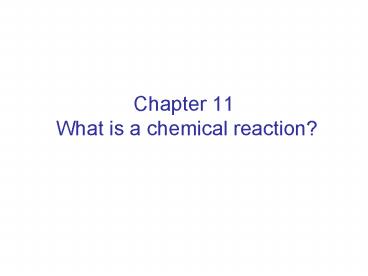Chapter 11 What is a chemical reaction? - PowerPoint PPT Presentation
1 / 20
Title:
Chapter 11 What is a chemical reaction?
Description:
Title: Chapter 9 9.1 What is a chemical reaction? Author: WilliAA Last modified by: CCSD Created Date: 1/24/2006 3:09:57 PM Document presentation format – PowerPoint PPT presentation
Number of Views:36
Avg rating:3.0/5.0
Title: Chapter 11 What is a chemical reaction?
1
Chapter 11 What is a chemical reaction?
2
Reactions involve rearrangements of atoms.
- Reactants are converted into products.
- The law of conservation of mass states that mass
cannot be created nor destroyed. - This means that the number of atoms in the
product must be equal to the original reactants.
3
- Atoms do not become other kinds of atoms, nor do
they appear or disappear.
4
Chemical reactions release or absorb energy
- Endothermic reaction- reaction in which energy is
absorbed. - - Bond formation always requires energy.
- Exothermic reaction- reaction in which energy is
released. - Bond breaking always releases energy.
5
- Particles must collide for a chemical reaction to
occur. - Example, when a safety match is lit, the reaction
begins when the two substances are brought
together by striking the match head across the
striking surface. - If this collision happens with enough energy, the
bonds in the reactants are broken, allowing new
bonds to form between the atoms.
6
Balancing Equations
7
Balancing requires patience
- To satisfy the law of conservation of mass, you
should insert coefficients into the chemical
equation in order to balance the number of
elements. - There must be equal numbers of atoms for each
element on each side of the equation when an
equation is balanced.
8
Testing an equation for balance
- Reactants Products
Balance? - Unbalanced
- Formula equation CH3CH2OH O2 CO2
H2O - Carbon atoms 2
1 No - Hydrogen atoms 6
2 No - Oxygen atoms 3
3 Yes
9
- To balance this equation, there are two carbon
atoms in the reactant column and only one in the
product column. - To balance the number of carbon atoms you need to
double the number of carbon dioxide molecules in
the products.
10
- CH3CH2OH ? O2 2CO2 ?
H2O - The 2 is called a coefficient and indicates
that there are two carbon dioxide molecules. - Coefficients are normal whole numbers, when a
coefficient is equal to 1, the 1 is not written
for simplicity. - Coefficients are written in front of the
formula and multiply the entire formula.
11
Testing an equation for balance
- Reactants Products
Balance? - Unbalanced
- Formula equation CH3CH2OH O2 2CO2
H2O - Carbon atoms 2
2 Yes - Hydrogen atoms 6
2 No - Oxygen atoms 3
5 No
12
- The carbon atoms are now balanced by the hydrogen
atoms are not. In addition the oxygen atoms have
been thrown out of balance. - Lets start with hydrogen, there are six in the
reactant column, so we must add three to the
product column.
13
Testing an equation for balance
- Reactants Products
Balance? - Unbalanced
- Formula equation CH3CH2OH O2 2CO2
3H2O - Carbon atoms 2
2 Yes - Hydrogen atoms 6
6 Yes - Oxygen atoms 3
7 No
14
- The oxygen atoms are still unbalanced.
- Multiplying the number of oxygen molecules by
three results in an equal number of oxygen atoms.
15
Testing an equation for balance
- Reactants Products
Balance? - Unbalanced
- Formula equation CH3CH2OH 3O2 2CO2
3H2O - Carbon atoms 2
2 Yes - Hydrogen atoms 6
6 Yes - Oxygen atoms 7
7 Yes
16
- Now you have written a balanced chemical
equation. - Replacing the question marks in the formula
equation with the right coefficients now give a
correct chemical equation.
17
Tips for balancing equations
- Save the elements that appear in several
reactants or products for last. (usually oxygen
and hydrogen ) - Balance lone elements last.
- Balance the equation from left to right.
- For ionic equations, be sure that charges are
balanced.
18
Testing an equation for balance
- Reactants Products
Balance? - Unbalanced
- Formula equation NH3 O2
NO H2O - Nitrogen atoms 1
1 Yes - Oxygen atoms 2
2 Yes - Hydrogen atoms 3
2 No
19
Testing an equation for balance
- Reactants Products
Balance? - Unbalanced
- Formula equation NH3 O2
NO H2O - Nitrogen atoms
- Oxygen atoms
- Hydrogen atoms
20
Testing an equation for balance
- Reactants Products
Balance? - Unbalanced
- Formula equation 4NH3 5O2 4NO
6H2O - Nitrogen atoms 4
4 Yes - Oxygen atoms 10
10 Yes - Hydrogen atoms 12
12 Yes

